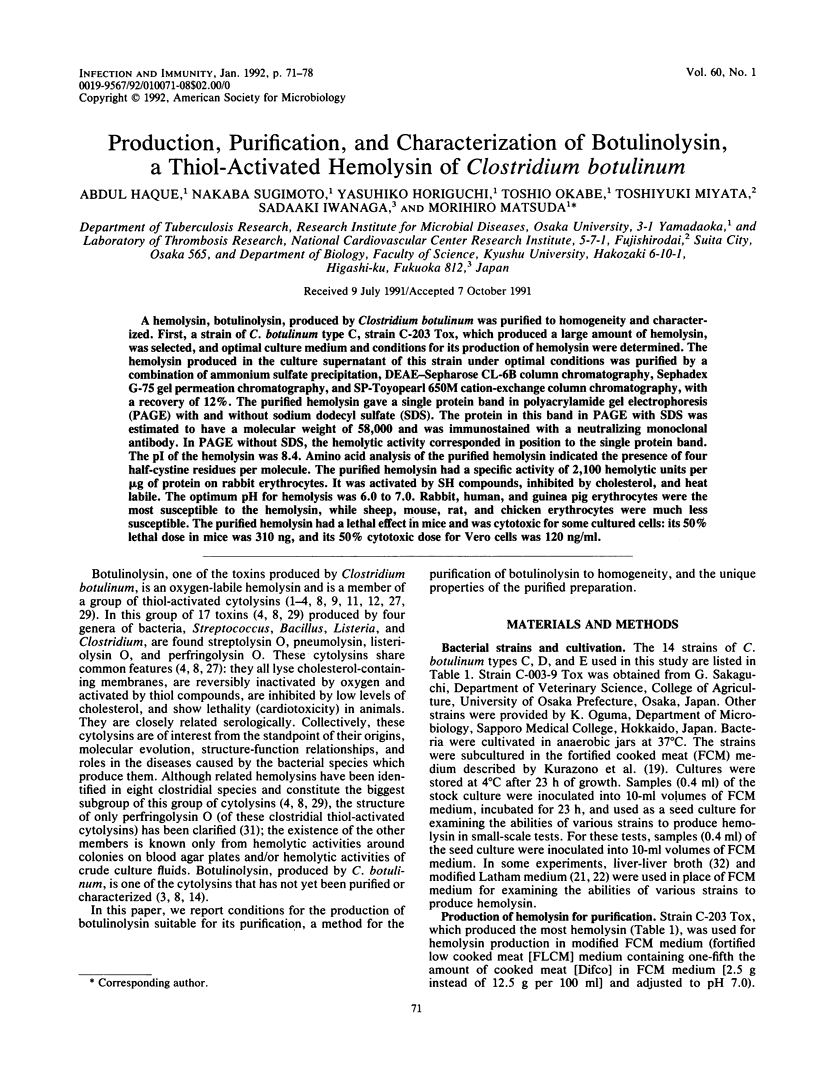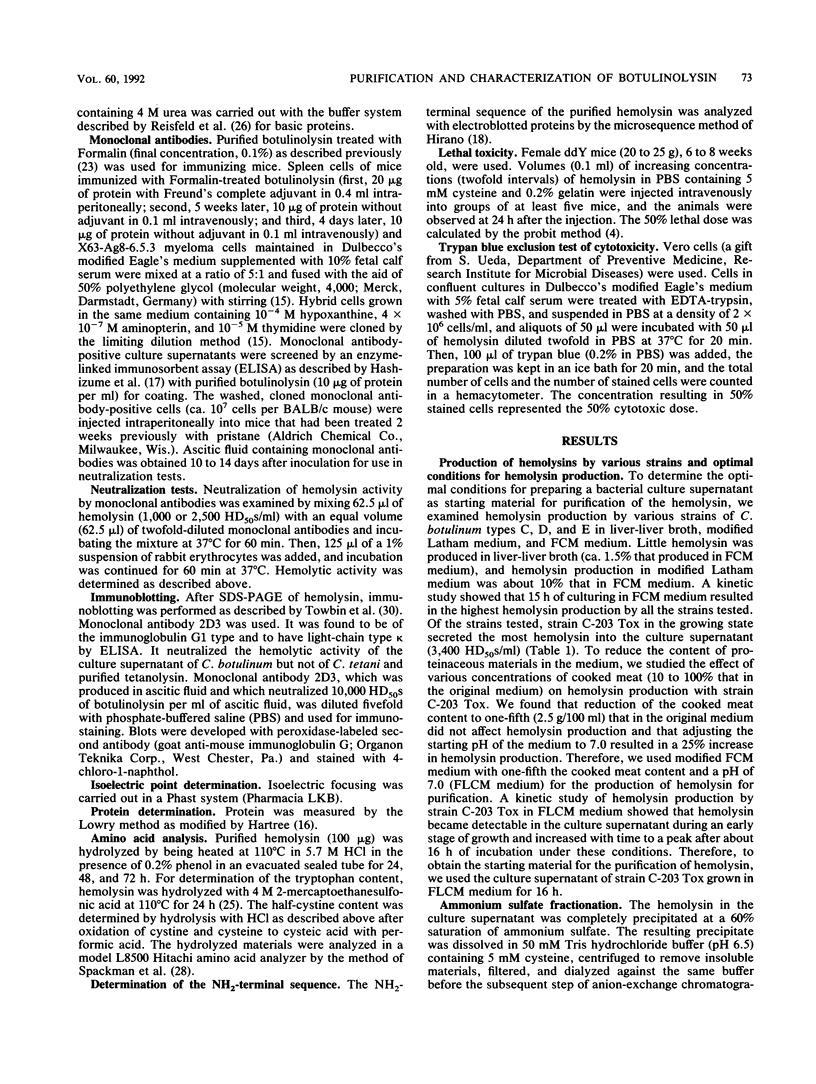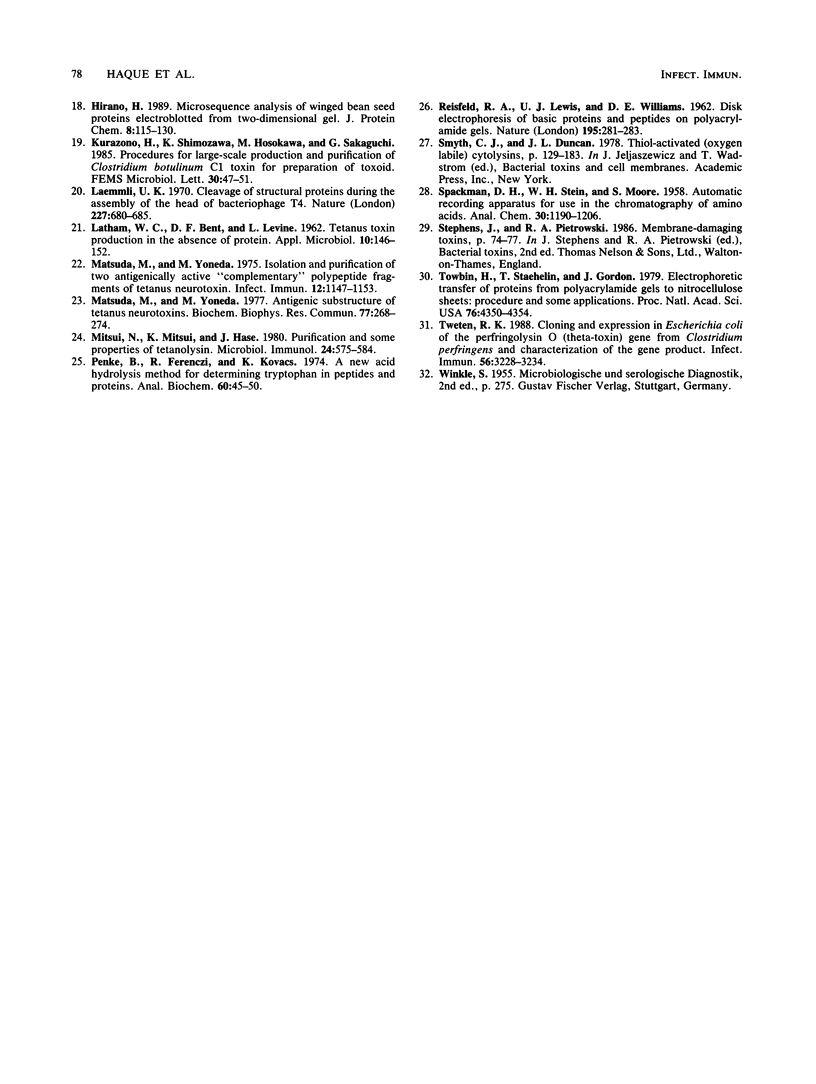Abstract
A hemolysin, botulinolysin, produced by Clostridium botulinum was purified to homogeneity and characterized. First, a strain of C. botulinum type C, strain C-203 Tox, which produced a large amount of hemolysin, was selected, and optimal culture medium and conditions for its production of hemolysin were determined. The hemolysin produced in the culture supernatant of this strain under optimal conditions was purified by a combination of ammonium sulfate precipitation, DEAE-Sepharose CL-6B column chromatography, Sephadex G-75 gel permeation chromatography, and SP-Toyopearl 650 M cation-exchange column chromatography, with a recovery of 12%. The purified hemolysin gave a single protein band in polyacrylamide gel electrophoresis (PAGE) with and without sodium dodecyl sulfate (SDS). The protein in this band in PAGE with SDS was estimated to have a molecular weight of 58,000 and was immunostained with a neutralizing monoclonal antibody. In PAGE without SDS, the hemolytic activity corresponded in position to the single protein band. The pI of the hemolysin was 8.4. Amino acid analysis of the purified hemolysin indicated the presence of four half-cystine residues per molecule. The purified hemolysin had a specific activity of 2,100 hemolytic units per microgram of protein on rabbit erythrocytes. It was activated by SH compounds, inhibited by cholesterol, and heat labile. The optimum pH for hemolysis was 6.0 to 7.0. Rabbit, human, and guinea pig erythrocytes were the most susceptible to the hemolysin, while sheep, mouse, rat, and chicken erythrocytes were much less susceptible. The purified hemolysin had a lethal effect in mice and was cytotoxic for some cultured cells: its 50% lethal dose in mice was 310 ng, and its 50% cytotoxic dose for Vero cells was 120 ng/ml.
Full text
PDF







Images in this article
Selected References
These references are in PubMed. This may not be the complete list of references from this article.
- Alouf J. E. Streptococcal toxins (streptolysin O, streptolysin S, erythrogenic toxin). Pharmacol Ther. 1980;11(3):661–717. doi: 10.1016/0163-7258(80)90045-5. [DOI] [PubMed] [Google Scholar]
- Bhakdi S., Roth M., Sziegoleit A., Tranum-Jensen J. Isolation and identification of two hemolytic forms of streptolysin-O. Infect Immun. 1984 Nov;46(2):394–400. doi: 10.1128/iai.46.2.394-400.1984. [DOI] [PMC free article] [PubMed] [Google Scholar]
- Cowell J. L., Grushoff-Kosyk P. S., Bernheimer A. W. Purification of cereolysin and the electrophoretic separation of the active (reduced) and inactive (oxidized) forms of the purified toxin. Infect Immun. 1976 Jul;14(1):144–154. doi: 10.1128/iai.14.1.144-154.1976. [DOI] [PMC free article] [PubMed] [Google Scholar]
- GUILLAUMIE M., KREGUER A. Nouvelles recherches sur les hémolysines oxydables. Ann Inst Pasteur (Paris) 1950 Apr;78(4):467–480. [PubMed] [Google Scholar]
- Geoffroy C., Alouf J. E. Selective purification by thiol-disulfide interchange chromatography of alveolysin, a sulfhydryl-activated toxin of Bacillus alvei. Toxin properties and interaction with cholesterol and liposomes. J Biol Chem. 1983 Aug 25;258(16):9968–9972. [PubMed] [Google Scholar]
- Geoffroy C., Gaillard J. L., Alouf J. E., Berche P. Production of thiol-dependent haemolysins by Listeria monocytogenes and related species. J Gen Microbiol. 1989 Mar;135(3):481–487. doi: 10.1099/00221287-135-3-481. [DOI] [PubMed] [Google Scholar]
- Geoffroy C., Gaillard J. L., Alouf J. E., Berche P. Purification, characterization, and toxicity of the sulfhydryl-activated hemolysin listeriolysin O from Listeria monocytogenes. Infect Immun. 1987 Jul;55(7):1641–1646. doi: 10.1128/iai.55.7.1641-1646.1987. [DOI] [PMC free article] [PubMed] [Google Scholar]
- Geoffroy C., Gilles A. M., Alouf J. E. The sulfhydryl groups of the thiol-dependent cytolytic toxin from Bacillus alvei evidence for one essential sulfhydryl group. Biochem Biophys Res Commun. 1981 Apr 15;99(3):781–788. doi: 10.1016/0006-291x(81)91233-x. [DOI] [PubMed] [Google Scholar]
- Geoffroy C., Mengaud J., Alouf J. E., Cossart P. Alveolysin, the thiol-activated toxin of Bacillus alvei, is homologous to listeriolysin O, perfringolysin O, pneumolysin, and streptolysin O and contains a single cysteine. J Bacteriol. 1990 Dec;172(12):7301–7305. doi: 10.1128/jb.172.12.7301-7305.1990. [DOI] [PMC free article] [PubMed] [Google Scholar]
- Hartree E. F. Determination of protein: a modification of the Lowry method that gives a linear photometric response. Anal Biochem. 1972 Aug;48(2):422–427. doi: 10.1016/0003-2697(72)90094-2. [DOI] [PubMed] [Google Scholar]
- Hashizume S., Mochizuki K., Murakami H., Yano T., Yasumoto K., Nomoto K. Serodiagnosis of cancer, using porcine antigens recognized by human monoclonal antibody, HB4C5. Biotherapy. 1989;1(2):109–115. doi: 10.1007/BF02170142. [DOI] [PubMed] [Google Scholar]
- Hirano H. Microsequence analysis of winged bean seed proteins electroblotted from two-dimensional gel. J Protein Chem. 1989 Feb;8(1):115–130. doi: 10.1007/BF01025083. [DOI] [PubMed] [Google Scholar]
- LATHAM W. C., BENT D. F., LEVINE L. Tetanus toxin production in the absence of protein. Appl Microbiol. 1962 Mar;10:146–152. doi: 10.1128/am.10.2.146-152.1962. [DOI] [PMC free article] [PubMed] [Google Scholar]
- Laemmli U. K. Cleavage of structural proteins during the assembly of the head of bacteriophage T4. Nature. 1970 Aug 15;227(5259):680–685. doi: 10.1038/227680a0. [DOI] [PubMed] [Google Scholar]
- Matsuda M., Yoneda M. Antigenic substructure of tetanus neurotoxin. Biochem Biophys Res Commun. 1977 Jul 11;77(1):268–274. doi: 10.1016/s0006-291x(77)80192-7. [DOI] [PubMed] [Google Scholar]
- Matsuda M., Yoneda M. Isolation and purification of two antigenically active, "complimentary" polypeptide fragments of tetanus neurotoxin. Infect Immun. 1975 Nov;12(5):1147–1153. doi: 10.1128/iai.12.5.1147-1153.1975. [DOI] [PMC free article] [PubMed] [Google Scholar]
- Mitsui N., Mitsui K., Hase J. Purification and some properties of tetanolysin. Microbiol Immunol. 1980;24(7):575–584. doi: 10.1111/j.1348-0421.1980.tb02860.x. [DOI] [PubMed] [Google Scholar]
- Penke B., Ferenczi R., Kovács K. A new acid hydrolysis method for determining tryptophan in peptides and proteins. Anal Biochem. 1974 Jul;60(1):45–50. doi: 10.1016/0003-2697(74)90129-8. [DOI] [PubMed] [Google Scholar]
- REISFELD R. A., LEWIS U. J., WILLIAMS D. E. Disk electrophoresis of basic proteins and peptides on polyacrylamide gels. Nature. 1962 Jul 21;195:281–283. doi: 10.1038/195281a0. [DOI] [PubMed] [Google Scholar]
- Towbin H., Staehelin T., Gordon J. Electrophoretic transfer of proteins from polyacrylamide gels to nitrocellulose sheets: procedure and some applications. Proc Natl Acad Sci U S A. 1979 Sep;76(9):4350–4354. doi: 10.1073/pnas.76.9.4350. [DOI] [PMC free article] [PubMed] [Google Scholar]
- Tweten R. K. Cloning and expression in Escherichia coli of the perfringolysin O (theta-toxin) gene from Clostridium perfringens and characterization of the gene product. Infect Immun. 1988 Dec;56(12):3228–3234. doi: 10.1128/iai.56.12.3228-3234.1988. [DOI] [PMC free article] [PubMed] [Google Scholar]




